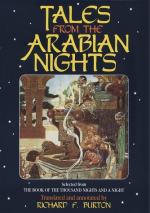After the death of the queen, who was killed of course when she turned into a troll, the king confessed that all the tasks which he had given his son to perform were undeserved and that he had acted thus, egged on by the queen. He called his son to him and humbly begged his forgiveness for what he had done against him. He declared he would atone for it by giving into his hand all that kingdom, while he himself only wished to live in peace and quiet for the rest of his days. So the young king sent for his queen and for the courtiers whom he loved most. And, to make a long story short, they gave up their former kingdom to the king with one eye, as a reward, for his lifetime, but governed the realm of the old king to a high age, in great glee and happiness,
The Two Sisters Who Envied Their Cadette—p. 313.
Legends of castaway infants are common to the folk-lore of almost all countries and date far back into antiquity. The most usual mode of exposing them—to perish or be rescued, as chance might direct—is placing them in a box and launching them into a river. The story of Moses in the bulrushes, which must of course be familiar to everybody, is not only paralleled in ancient Greek and Roman legends (e.g. Perseus, Cyrus, Romulus), but finds its analogue in Babylonian folk-lore.[FN#425] The leading idea of the tale of the Envious Sisters, who substituted a puppy, a kitten, and a rat for the three babes their young sister the queen had borne and sent the little innocents away to be destroyed, appealing, as it does to the strongest of human instincts, is the theme of many popular fictions from India to Iceland. With a malignant mother-in-law in place of the two sisters, it is the basis of a mediaeval European romance entitled “The Knight of the Swan,” and of a similar tale which occurs in “Dolopathus,” the oldest version of the “Seven Wise Masters,” written in Latin prose about the year 1180: A king while hunting loses his way in a forest and coming to a fountain perceives a beautiful lady, whom he carries home and duly espouses much against the will of his mother, Matabrun. Some time after, having to lead his knights and men-at-arms against an enemy, he commits the queen, now far advanced in pregnancy to the care




